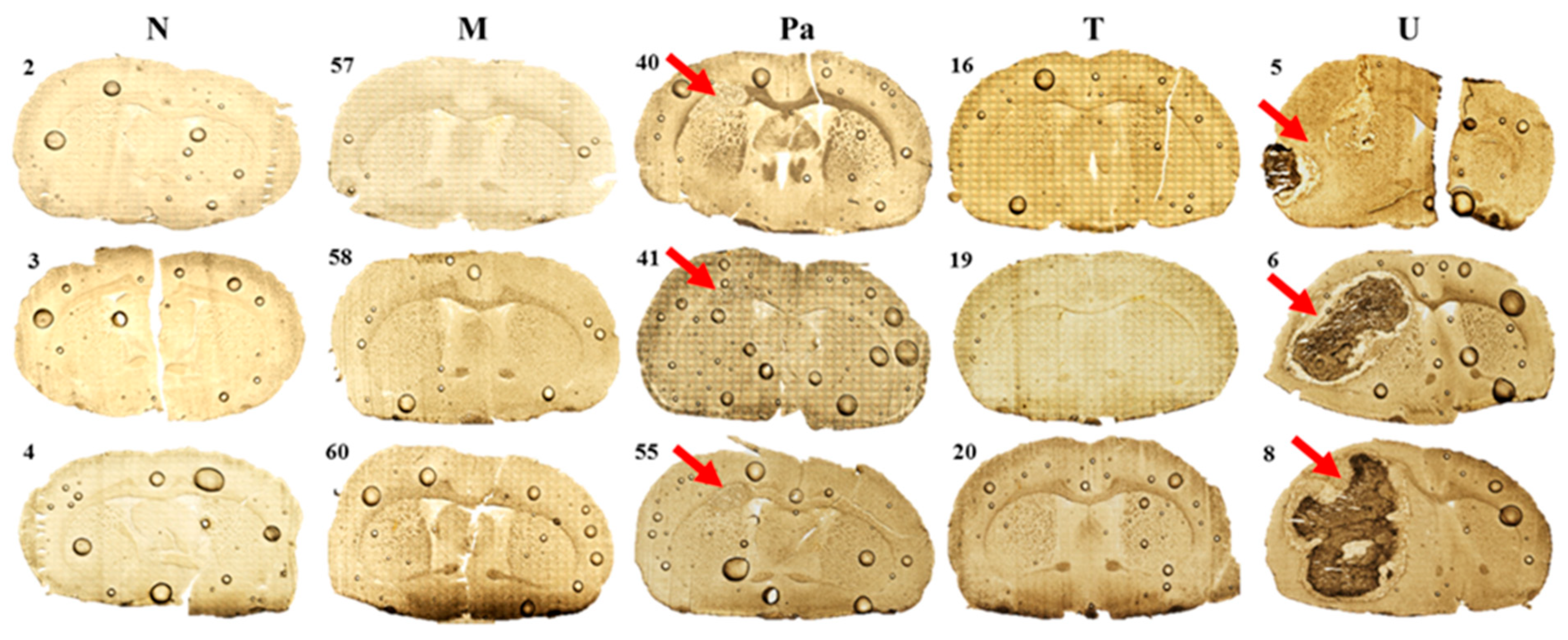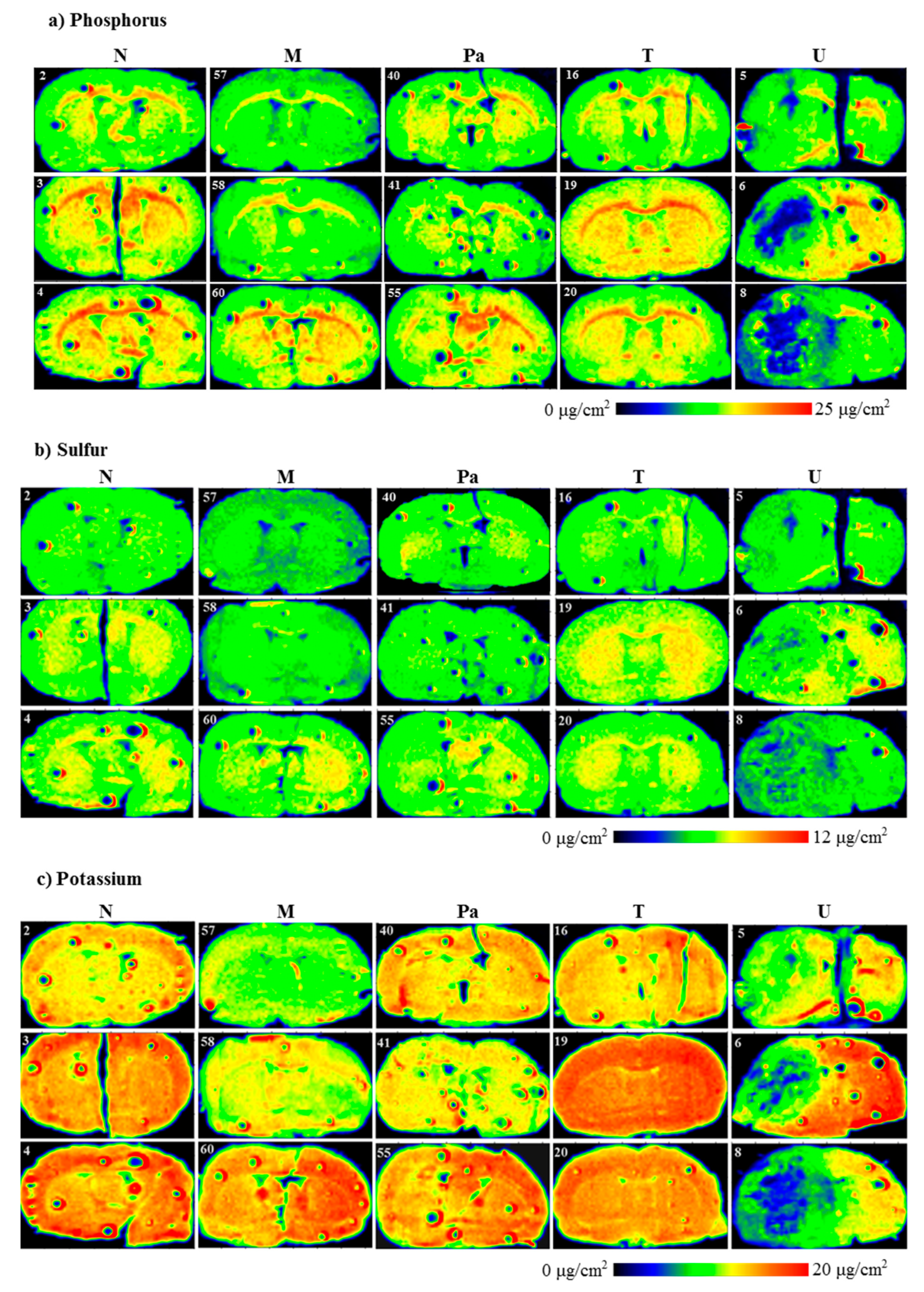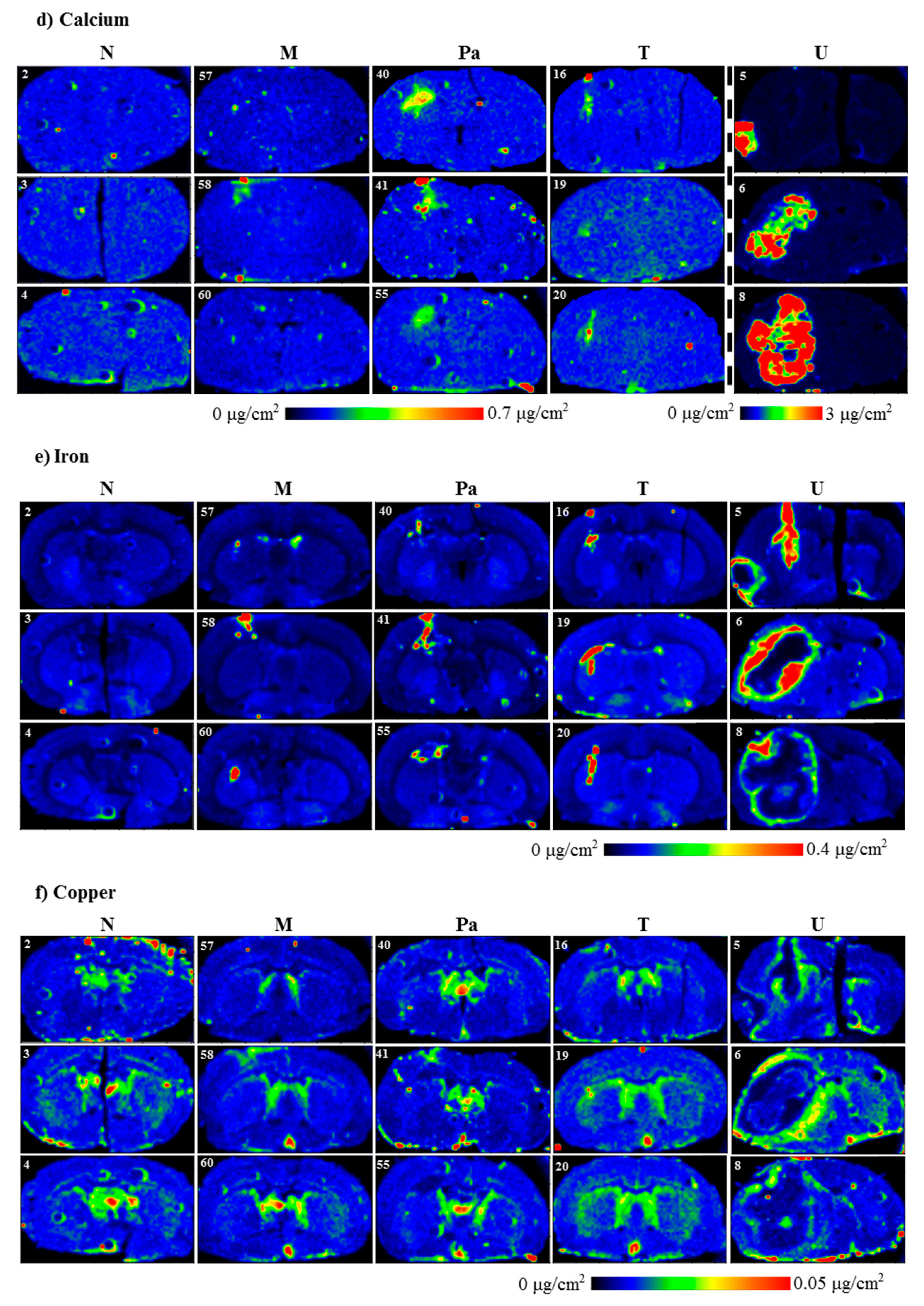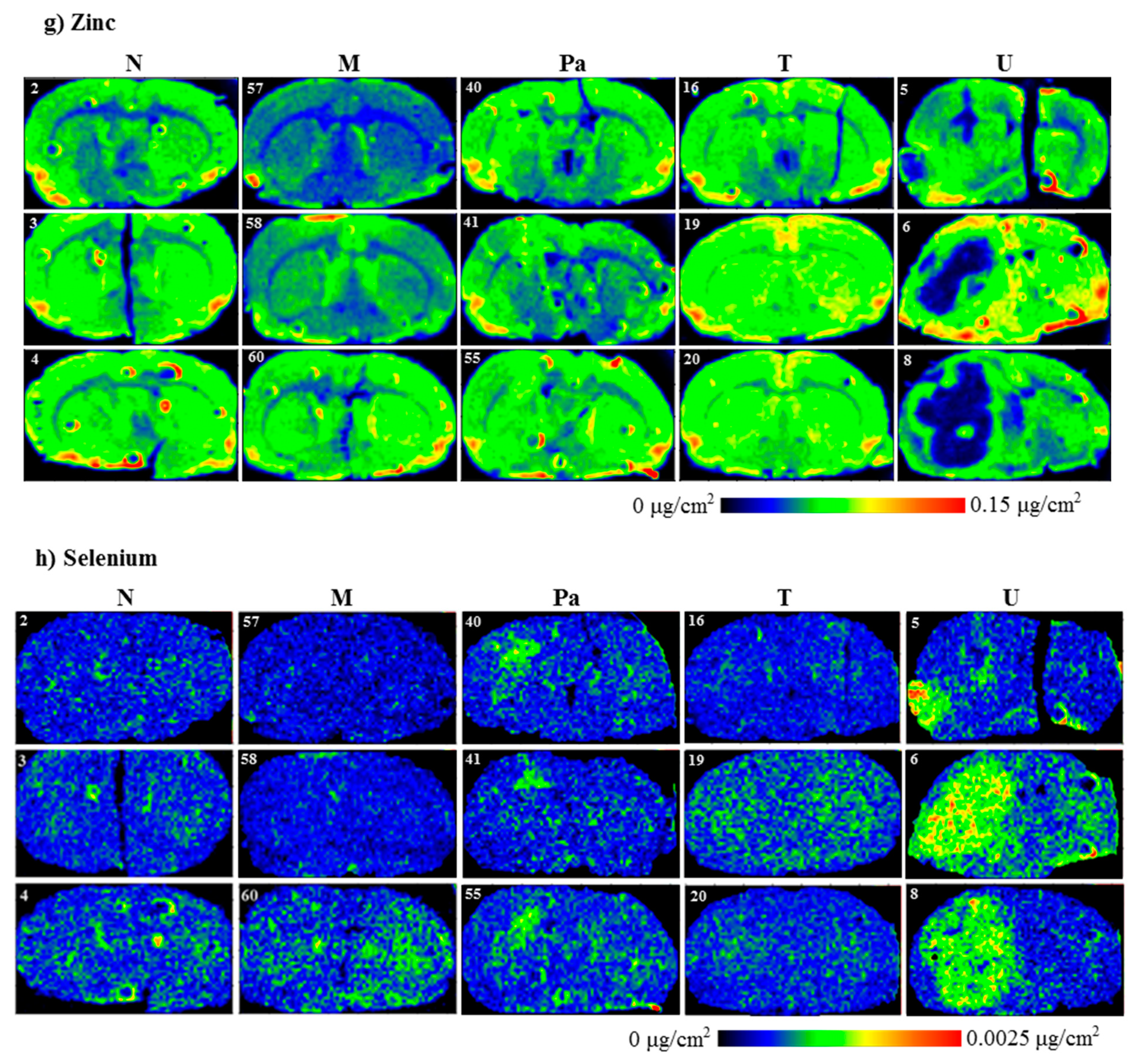Altered Elemental Distribution in Male Rat Brain Tissue as a Predictor of Glioblastoma Multiforme Growth—Studies Using SR-XRF Microscopy
Abstract
1. Introduction
2. Results
2.1. Outline of the Experiment
2.2. Data Analysis
- —the areal density of the analyzed element in the tissue sample (μg/cm2);
- —the net peak area of the Kα line of the measured element for the tissue sample (a.u.);
- S—sensitivity for the measured element (cm2/μg);
- —the incoming X-ray beam normalization factor for the tissue sample (a.u.).
- —the net peak area of the Kα line of the measured element for the standard sample (a.u);
- —the areal density of the analyzed element in the standard sample (μg/cm2);
- —the incoming X-ray beam normalization factor for the standard sample (a.u.).
2.3. Limits of Detection
- —the integrated area of the background under the Kα line of element i in the spectrum recorded for tissue point j (a.u.);
- —the net peak area of the Kα line of element i in the spectrum recorded for tissue point j (a.u.);
- —the areal density of element i in tissue point j (μg/cm2).
- —the detection limit of element i for the brain tissue, calculated as an average of the results for all the selected tissue points (μg/cm2);
- n—the number of examined points.
2.4. Morphological Evaluation
2.5. Qualitative Elemental Analysis
2.6. Quantitative Elemental Analysis
3. Discussion
4. Materials and Methods
5. Conclusions
Author Contributions
Funding
Institutional Review Board Statement
Informed Consent Statement
Data Availability Statement
Acknowledgments
Conflicts of Interest
References
- Czapski, B.; Baluszek, S.; Herold-Mende, C.; Kaminska, B. Clinical and immunological correlates of long term survival in glioblastoma. Contemp. Oncol. 2018, 22, 81–85. [Google Scholar] [CrossRef] [PubMed]
- Ostrom, Q.T.; Patil, N.; Cioffi, G.; Waite, K.; Kruchko, C.; Barnholtz-Sloan, J.S. CBTRUS Statistical Report: Primary Brain and Other Central Nervous System Tumors Diagnosed in the United States in 2013–2017. Neuro-Oncology 2020, 22, iv1–iv96. [Google Scholar] [CrossRef]
- Depciuch, J.; Tołpa, B.; Witek, P.; Szmuc, K.; Kaznowska, E.; Osuchowski, M.; Król, P.; Cebulski, J. Raman and FTIR spectroscopy in determining the chemical changes in healthy brain tissues and glioblastoma tumor tissues. Spectrochim. Acta Part A Mol. Biomol. Spectrosc. 2020, 225, 117526. [Google Scholar] [CrossRef]
- Szczerbowska-Boruchowska, M.; Lankosz, M.; Adamek, D. First step toward the “fingerprinting” of brain tumors based on synchrotron radiation X-ray fluorescence and multiple discriminant analysis. JBIC J. Biol. Inorg. Chem. 2011, 16, 1217–1226. [Google Scholar] [CrossRef]
- Gregory, J.V.; Kadiyala, P.; Doherty, R.; Cadena, M.; Habeel, S.; Ruoslahti, E.; Lowenstein, P.R.; Castro, M.G.; Lahann, J. Systemic brain tumor delivery of synthetic protein nanoparticles for glioblastoma therapy. Nat. Commun. 2020, 11, 5687. [Google Scholar] [CrossRef] [PubMed]
- Song, X.; Shu, X.-H.; Wu, M.-L.; Zheng, X.; Jia, B.; Kong, Q.-Y.; Liu, J.; Li, H. Postoperative resveratrol administration improves prognosis of rat orthotopic glioblastomas. BMC Cancer 2018, 18, 871. [Google Scholar] [CrossRef]
- Marrero, L.; Wyczechowska, D.; Musto, A.E.; Wilk, A.; Vashistha, H.; Zapata, A.; Walker, C.; Velasco-Gonzalez, C.; Parsons, C.; Wieland, S.; et al. Therapeutic Efficacy of Aldoxorubicin in an Intracranial Xenograft Mouse Model of Human Glioblastoma. Neoplasia 2014, 16, 874–882. [Google Scholar] [CrossRef] [PubMed]
- Chwiej, J.; Patulska, A.; Skoczen, A.; Janeczko, K.; Ciarach, M.; Simon, R.; Setkowicz, Z. Elemental changes in the hippocampal formation following two different formulas of ketogenic diet: An X-ray fluorescence microscopy study. JBIC J. Biol. Inorg. Chem. 2015, 20, 1277–1286. [Google Scholar] [CrossRef][Green Version]
- Turyanskaya, A.; Rauwolf, M.; Pichler, V.; Simon, R.; Burghammer, M.; Fox, O.J.L.; Sawhney, K.; Hofstaetter, J.G.; Roschger, A.; Roschger, P.; et al. Detection and imaging of gadolinium accumulation in human bone tissue by micro- and submicro-XRF. Sci. Rep. 2020, 10, 6301. [Google Scholar] [CrossRef] [PubMed]
- Osterode, W.; Falkenberg, G.; Ferenci, P.; Wrba, F. Quantitative trace element mapping in liver tissue from patients with Wilson‘s disease determined by micro X-ray fluorescence. J. Trace Elem. Med. Biol. 2019, 51, 42–49. [Google Scholar] [CrossRef]
- Farquharson, M.J.; Al-Ebraheem, A.; Falkenberg, G.; Leek, R.; Harris, A.L.; Bradley, D.A. The distribution of trace elements Ca, Fe, Cu and Zn and the determination of copper oxidation state in breast tumour tissue using μSRXRF and μXANES. Phys. Med. Biol. 2008, 53, 3023–3037. [Google Scholar] [CrossRef]
- Xiao, A.Y.; Maynard, M.R.; Piett, C.G.; Nagel, Z.D.; Alexander, J.S.; Kevil, C.G.; Berridge, M.V.; Pattillo, C.B.; Rosen, L.R.; Miriyala, S.; et al. Sodium sulfide selectively induces oxidative stress, DNA damage, and mitochondrial dysfunction and radiosensitizes glioblastoma (GBM) cells. Redox Biol. 2019, 26, 101220. [Google Scholar] [CrossRef] [PubMed]
- Huang, L.; Li, B.; Li, W.; Guo, H.; Zou, F. ATP-sensitive potassium channels control glioma cells proliferation by regulating ERK activity. Carcinogenesis 2009, 30, 737–744. [Google Scholar] [CrossRef] [PubMed]
- Martin, F.; Lemmen, L.J. Calcification in intracranial neoplasms. Am. J. Pathol. 1952, 28, 1107–1131. [Google Scholar] [PubMed]
- Finney, L.; Vogt, S.; Fukai, T.; Glesne, D. Copper and angiogenesis: Unravelling a relationship key to cancer progression. Clin. Exp. Pharmacol. Physiol. 2009, 36, 88–94. [Google Scholar] [CrossRef] [PubMed]
- Torti, S.V.; Torti, F.M. Iron and cancer: More ore to be mined. Nat. Rev. Cancer 2013, 13, 342–355. [Google Scholar] [CrossRef]
- MacDonald, R.S. The Role of Zinc in Growth and Cell Proliferation. J. Nutr. 2000, 130, 1500S–1508S. [Google Scholar] [CrossRef]
- Guisun, Z.; Yinson, W.; Mingguang, T.; Min, Z.; Yongjie, W.; Fulin, Z. Preliminary study of trace elements in human brain tumor tissues by instrumental neutron activation analysis. J. Radioanal. Nucl. Chem. Artic. 1991, 151, 327–335. [Google Scholar] [CrossRef]
- Brozmanová, J.; Mániková, D.; Vlčková, V.; Chovanec, M. Selenium: A double-edged sword for defense and offence in cancer. Arch. Toxicol. 2010, 84, 919–938. [Google Scholar] [CrossRef]
- Planeta, K.; Setkowicz, Z.; Janik-Olchawa, N.; Matusiak, K.; Ryszawy, D.; Drozdz, A.; Janeczko, K.; Ostachowicz, B.; Chwiej, J. Comparison of Elemental Anomalies Following Implantation of Different Cell Lines of Glioblastoma Multiforme in the Rat Brain: A Total Reflection X-ray Fluorescence Spectroscopy Study. ACS Chem. Neurosci. 2020, 11, 4447–4459. [Google Scholar] [CrossRef]
- Solé, V.A.; Papillon, E.; Cotte, M.; Walter, P.; Susini, J. A Multiplatform Code for the Analysis of Energy-Dispersive X-ray Fluorescence Spectra. Spectrochim. Acta Part B At. Spectrosc. 2007, 62, 63–68. [Google Scholar] [CrossRef]
- Nachar, N. The Mann-Whitney U: A Test for Assessing Whether Two Independent Samples Come from the Same Distribution. Tutor. Quant. Methods Psychol. 2008, 4, 13–20. [Google Scholar] [CrossRef]
- Wandzilak, A.; Czyzycki, M.; Radwanska, E.; Adamek, D.; Geraki, K.; Lankosz, M. X-ray fluorescence study of the concentration of selected trace and minor elements in human brain tumours. Spectrochim. Acta Part B At. Spectrosc. 2015, 114, 52–57. [Google Scholar] [CrossRef]
- Chiba, R.; Morikawa, N.; Sera, K.; Ishida, K.; Nagashima, H.; Shigeeda, W.; Deguchi, H.; Tomoyasu, M.; Hosokawa, T.; Saito, H.; et al. Elemental and mutational analysis of lung tissue in lung adenocarcinoma patients. Transl. Lung Cancer Res. 2019, 8, S224–S234. [Google Scholar] [CrossRef] [PubMed]
- Al-Ebraheem, A.; Dao, E.; Geraki, K.; Farquharson, M.J. Emerging Patterns in the Distribution of Trace Elements in Ovarian, Invasive and In-Situ Breast Cancer. J. Phys. Conf. Ser. 2014, 499, 012014. [Google Scholar] [CrossRef]
- Pamphlett, R.; Satgunaseelan, L.; Jew, S.K.; Doble, P.A.; Bishop, D.P. Elemental bioimaging shows mercury and other toxic metals in normal breast tissue and in breast cancers. PLoS ONE 2020, 15, e0228226. [Google Scholar] [CrossRef]
- Selverstone, B.; Moulton, M.J. The phosphorus metabolism of gliomas: A study with radioactive isotopes. Brain 1957, 80, 362–375. [Google Scholar] [CrossRef]
- Schonberg, D.L.; Miller, T.E.; Wu, Q.; Flavahan, W.A.; Das, N.K.; Hale, J.S.; Hubert, C.G.; Mack, S.C.; Jarrar, A.M.; Karl, R.T.; et al. Preferential Iron Trafficking Characterizes Glioblastoma Stem-like Cells. Cancer Cell 2015, 28, 441–455. [Google Scholar] [CrossRef]
- Dejos, C.; Gkika, D.; Cantelmo, A.R. The Two-Way Relationship Between Calcium and Metabolism in Cancer. Front. Cell Dev. Biol. 2020, 8, 573747. [Google Scholar] [CrossRef]
- Hsu, M.Y.; Mina, E.; Roetto, A.; Porporato, P.E. Iron: An Essential Element of Cancer Metabolism. Cells 2020, 9, 2591. [Google Scholar] [CrossRef] [PubMed]
- Xiao, Y.; Chen, D.; Zhang, X.; Cui, Q.; Fan, Y.; Bi, C.; Dou, Q.P. Molecular study on copper-mediated tumor proteasome inhibition and cell death. Int. J. Oncol. 2010, 37, 81–87. [Google Scholar] [CrossRef] [PubMed]
- Yu, Y.; Gutierrez, E.; Kovacevic, Z.; Saletta, F.; Obeidy, P.; Suryo Rahmanto, Y.; Richardson, D.R. Iron Chelators for the Treatment of Cancer. Curr. Med. Chem. 2012, 19, 2689–2702. [Google Scholar] [CrossRef] [PubMed]
- Evans, S.O.; Khairuddin, P.F.; Jameson, M.B. Optimising Selenium for Modulation of Cancer Treatments. Anticancer Res. 2017, 37, 6497–6509. [Google Scholar]
- Ishimura, M.; Yamamoto, Y.; Mitamura, K.; Norikane, T.; Nishiyama, Y. A Case of Glioblastoma With Calcified Region Imaged With 18F-NaF PET/CT. Clin. Nucl. Med. 2018, 43, 764–765. [Google Scholar] [CrossRef] [PubMed]
- Kubota, T.; Kogure, Y.; Yamamoto, S.; Matsubara, S.; Kitano, T.; Hayashi, M. Calcification in glioblastoma multiforme of the cervical spinal cord. Surg. Neurol. 1986, 26, 183–186. [Google Scholar] [CrossRef]
- Mallya, V.; Siraj, F.; Singh, A.; Sharma, K. Giant cell glioblastoma with calcification and long-term survival. Indian J. Cancer 2015, 52, 704. [Google Scholar] [CrossRef]
- Kroh, H.; Matyja, E.; Marchel, A.; Bojarski, P. Heavily lipidized, calcified giant cell glioblastoma in an 8-year-old patient, associated with neurofibromatosis type 1 (NF1): Report of a case with long-term survival. Clin. Neuropathol. 2004, 23, 286–291. [Google Scholar]
- Zeng, Y.; Zhu, X.; Wang, Y.; Liu, B.; Yang, X.; Wang, Q.; Du, J.; Ma, Y.; Lin, L.; Fu, P.; et al. Clinicopathological, Immunohistochemical and Molecular Genetic Study on Epithelioid Glioblastoma: A Series of Fifteen Cases with Literature Review. OncoTargets Ther. 2020, 13, 3943–3952. [Google Scholar] [CrossRef]
- Bhatoe, H.S.; Kumar, H. Calcified occipital glioblastoma. Neurol. India 2004, 52, 130. [Google Scholar]
- Broniscer, A.; Tatevossian, R.G.; Sabin, N.D.; Klimo, P.; Dalton, J.; Lee, R.; Gajjar, A.; Ellison, D.W. Clinical, radiological, histological and molecular characteristics of paediatric epithelioid glioblastoma: Epithelioid glioblastoma in children. Neuropathol. Appl. Neurobiol. 2014, 40, 327–336. [Google Scholar] [CrossRef]
- Bähr, O.; Hattingen, E.; Rieger, J.; Steinbach, J.P. Bevacizumab-induced tumor calcifications as a surrogate marker of outcome in patients with glioblastoma. Neuro-Oncology 2011, 13, 1020–1029. [Google Scholar] [CrossRef]
- Blumenthal, D.T.; Aisenstein, O.; Ben-Horin, I.; Ben Bashat, D.; Artzi, M.; Corn, B.W.; Kanner, A.A.; Ram, Z.; Bokstein, F. Calcification in high grade gliomas treated with bevacizumab. J. Neuro-Oncol. 2015, 123, 283–288. [Google Scholar] [CrossRef]
- Weiseenthal, L.; Williamson, S.; Brunschwiler, C.; Rueff-Weisenthal, C. Bevacizumab-induced tumor calcifications can be elicited in glioblastoma microspheroid culture and represent massive calcium accumulation death (MCAD) of tumor endothelial cells. Nat. Preced. 2012. [Google Scholar] [CrossRef]
- Halpin, S.; Kingsley, D. Disappearance of cerebral calcification as a sign of tumor growth. Am. J. Neuroradiol. 1993, 14, 119–122. [Google Scholar]
- Ye, Z.-C.; Sontheimer, H. Glioma Cells Release Excitotoxic Concentrations of Glutamate. Cancer Res. 1999, 59, 4383–4391. [Google Scholar] [PubMed]
- Noch, E.; Khalili, K. Molecular mechanisms of necrosis in glioblastoma: The role of glutamate excitotoxicity. Cancer Biol. Ther. 2009, 8, 1791–1797. [Google Scholar] [CrossRef] [PubMed]
- Liu, S.; Wang, Y.; Xu, K.; Wang, Z.; Fan, X.; Zhang, C.; Li, S.; Qiu, X.; Jiang, T. Relationship between necrotic patterns in glioblastoma and patient survival: Fractal dimension and lacunarity analyses using magnetic resonance imaging. Sci. Rep. 2017, 7, 8302. [Google Scholar] [CrossRef] [PubMed]
- Chwiej, J.; Gabrys, H.; Janeczko, K.; Kutorasinska, J.; Gzielo-Jurek, K.; Matusiak, K.; Appel, K.; Setkowicz, Z. Elemental anomalies in the hippocampal formation after repetitive electrical stimulation: An X-ray fluorescence microscopy study. J. Biol. Inorg. Chem. 2014, 19, 1209. [Google Scholar] [CrossRef][Green Version]
- Deshpande, J.K.; Siesjö, B.K.; Wieloch, T. Calcium Accumulation and Neuronal Damage in the Rat Hippocampus following Cerebral Ischemia. J. Cereb. Blood Flow Metab. 1987, 7, 89–95. [Google Scholar] [CrossRef]
- Dorsett, C.R.; McGuire, J.L.; DePasquale, E.A.K.; Gardner, A.E.; Floyd, C.L.; McCullumsmith, R.E. Glutamate Neurotransmission in Rodent Models of Traumatic Brain Injury. J. Neurotrauma 2017, 34, 263–272. [Google Scholar] [CrossRef] [PubMed]
- Shen, Y.; Li, X.; Dong, D.; Zhang, B.; Xue, Y.; Shang, P. Transferrin receptor 1 in cancer: A new sight for cancer therapy. Am. J. Cancer Res. 2018, 8, 916–931. [Google Scholar]
- Richardson, D.R. Iron chelators as therapeutic agents for the treatment of cancer. Crit. Rev. Oncol./Hematol. 2002, 42, 267–281. [Google Scholar] [CrossRef]
- Chirasani, S.R.; Markovic, D.S.; Synowitz, M.; Eichler, S.A.; Wisniewski, P.; Kaminska, B.; Otto, A.; Wanker, E.; Schäfer, M.; Chiarugi, P.; et al. Transferrin-receptor-mediated iron accumulation controls proliferation and glutamate release in glioma cells. J. Mol. Med. 2009, 87, 153–167. [Google Scholar] [CrossRef]
- Behr, S.C.; Villanueva-Meyer, J.E.; Li, Y.; Wang, Y.-H.; Wei, J.; Moroz, A.; Lee, J.K.L.; Hsiao, J.C.; Gao, K.T.; Ma, W.; et al. Targeting iron metabolism in high-grade glioma with 68Ga-citrate PET/MR. JCI Insight 2018, 3, e93999. [Google Scholar] [CrossRef]
- Nishikawa, M.; Inoue, A.; Ohnishi, T.; Kohno, S.; Ohue, S.; Matsumoto, S.; Suehiro, S.; Yamashita, D.; Ozaki, S.; Watanabe, H.; et al. Significance of Glioma Stem-Like Cells in the Tumor Periphery That Express High Levels of CD44 in Tumor Invasion, Early Progression, and Poor Prognosis in Glioblastoma. Stem Cells Int. 2018, 2018, 5387041. [Google Scholar] [CrossRef] [PubMed]
- Karginova, O.; Weekley, C.M.; Raoul, A.; Alsayed, A.; Wu, T.; Lee, S.S.-Y.; He, C.; Olopade, O.I. Inhibition of Copper Transport Induces Apoptosis in Triple-Negative Breast Cancer Cells and Suppresses Tumor Angiogenesis. Mol. Cancer Ther. 2019, 18, 873–885. [Google Scholar] [CrossRef] [PubMed]
- Yoshida, D.; Ikeda, Y.; Nakazawa, S. Copper Chelation Inhibits Tumor Angiogenesis in the Experimental 9L Gliosarcoma Model. Neurosurgery 1995, 37, 287–293. [Google Scholar] [CrossRef]
- Brewer, G.J.; Dick, R.D.; Grover, D.K.; LeClaire, V.; Tseng, M.; Wicha, M.; Pienta, K.; Redman, B.G.; Jahan, T.; Sondak, V.K.; et al. Treatment of Metastatic Cancer with Tetrathiomolybdate, an Anticopper, Antiangiogenic Agent: Phase I Study. Clin. Cancer Res. 2000, 6, 1–10. [Google Scholar] [PubMed]
- Zowczak, M.; Iskra, M.; Torliński, L.; Cofta, S. Analysis of Serum Copper and Zinc Concentrations in Cancer Patients. Biol. Trace Elem. Res. 2001, 82, 001–008. [Google Scholar] [CrossRef]
- Milanino, R.; Marrella, M.; Gasperini, R.; Pasqualicchio, M.; Velo, G. Copper and zinc body levels in inflammation: An overview of the data obtained from animal and human studies. Agents Actions 1993, 39, 195–209. [Google Scholar] [CrossRef]
- Dehnhardt, M.; Zoriy, M.V.; Khan, Z.; Reifenberger, G.; Ekström, T.J.; Sabine Becker, J.; Zilles, K.; Bauer, A. Element distribution is altered in a zone surrounding human glioblastoma multiforme. J. Trace Elem. Med. Biol. 2008, 22, 17–23. [Google Scholar] [CrossRef]
- Harmanci, D. In Vitro Effects of Selenium on Human Glioblastoma Multiforme Cell Lines: A Preliminary Study. Acta Clin. Croat. 2017, 56, 48–57. [Google Scholar] [CrossRef]
- Stojsavljević, A.; Vujotić, L.; Rovčanin, B.; Borković-Mitić, S.; Gavrović-Jankulović, M.; Manojlović, D. Assessment of trace metal alterations in the blood, cerebrospinal fluid and tissue samples of patients with malignant brain tumors. Sci. Rep. 2020, 10, 3816. [Google Scholar] [CrossRef] [PubMed]
- Civit, T.; Houdayer, A.J.; Kennedy, G. A search for trace elements in some human intracranial tumors by instrumental neutron activation analysis. Biol. Trace Elem. Res. 2000, 74, 203–210. [Google Scholar] [CrossRef]
- Zhang, Z.; Chinen, Y.; Zhu, Z.; Kimura, M.; Itokawa, Y. Uptake and distribution of sodium selenite in rat brain tumor. Biol. Trace Elem. Res. 1995, 48, 45–50. [Google Scholar] [CrossRef] [PubMed]
- Tian, M.; Ma, W.; Chen, Y.; Yu, Y.; Zhu, D.; Shi, J.; Zhang, Y. Impact of gender on the survival of patients with glioblastoma. Biosci. Rep. 2018, 38, BSR20180752. [Google Scholar] [CrossRef] [PubMed]
- Paxinos, G.; Watson, C. The Rat Brain in Stereotaxic Coordinates; Academic Press: New York, NY, USA, 1986. [Google Scholar]
- Simon, R.; Buth, G.; Hagelstein, M. The X-ray-fluorescence facility at ANKA, Karlsruhe: Minimum detection limits and micro probe capabilities. Nucl. Instrum. Methods Phys. Res. Sect. B Beam Interact. Mater. At. 2003, 199, 554–558. [Google Scholar] [CrossRef]







| Element | P | S | K | Ca | Fe | Cu | Zn | Se |
|---|---|---|---|---|---|---|---|---|
| LOD (ng/cm2) | 355.4 | 122.7 | 39.36 | 12.25 | 2.695 | 1.126 | 1.544 | 0.4493 |
| SD (ng/cm2) | 3.8 | 1.3 | 0.41 | 0.13 | 0.028 | 0.012 | 0.015 | 0.0073 |
| Animal Group | Characteristics |
|---|---|
| N | Naive, normal rats (without implantation) |
| M | Implantation of 5 μL of Dulbecco’s Modified Eagle Medium (DMEM) used for preparation of cell suspensions |
| Pa | Implantation of human GBM cells extracted from a patient, suspended in 5 μL of DMEM, 50,000 cells/µl |
| T | Implantation of cultured human GBM cell line T98g, suspended in 5 μL of DMEM, 50,000 cells/µl |
| U | Implantation of cultured human GBM cell line U87mg, suspended in 5 μL of DMEM, 5000 cells/µl |
Publisher’s Note: MDPI stays neutral with regard to jurisdictional claims in published maps and institutional affiliations. |
© 2022 by the authors. Licensee MDPI, Basel, Switzerland. This article is an open access article distributed under the terms and conditions of the Creative Commons Attribution (CC BY) license (https://creativecommons.org/licenses/by/4.0/).
Share and Cite
Planeta, K.; Setkowicz, Z.; Czyzycki, M.; Janik-Olchawa, N.; Ryszawy, D.; Janeczko, K.; Simon, R.; Baumbach, T.; Chwiej, J. Altered Elemental Distribution in Male Rat Brain Tissue as a Predictor of Glioblastoma Multiforme Growth—Studies Using SR-XRF Microscopy. Int. J. Mol. Sci. 2022, 23, 703. https://doi.org/10.3390/ijms23020703
Planeta K, Setkowicz Z, Czyzycki M, Janik-Olchawa N, Ryszawy D, Janeczko K, Simon R, Baumbach T, Chwiej J. Altered Elemental Distribution in Male Rat Brain Tissue as a Predictor of Glioblastoma Multiforme Growth—Studies Using SR-XRF Microscopy. International Journal of Molecular Sciences. 2022; 23(2):703. https://doi.org/10.3390/ijms23020703
Chicago/Turabian StylePlaneta, Karolina, Zuzanna Setkowicz, Mateusz Czyzycki, Natalia Janik-Olchawa, Damian Ryszawy, Krzysztof Janeczko, Rolf Simon, Tilo Baumbach, and Joanna Chwiej. 2022. "Altered Elemental Distribution in Male Rat Brain Tissue as a Predictor of Glioblastoma Multiforme Growth—Studies Using SR-XRF Microscopy" International Journal of Molecular Sciences 23, no. 2: 703. https://doi.org/10.3390/ijms23020703
APA StylePlaneta, K., Setkowicz, Z., Czyzycki, M., Janik-Olchawa, N., Ryszawy, D., Janeczko, K., Simon, R., Baumbach, T., & Chwiej, J. (2022). Altered Elemental Distribution in Male Rat Brain Tissue as a Predictor of Glioblastoma Multiforme Growth—Studies Using SR-XRF Microscopy. International Journal of Molecular Sciences, 23(2), 703. https://doi.org/10.3390/ijms23020703







